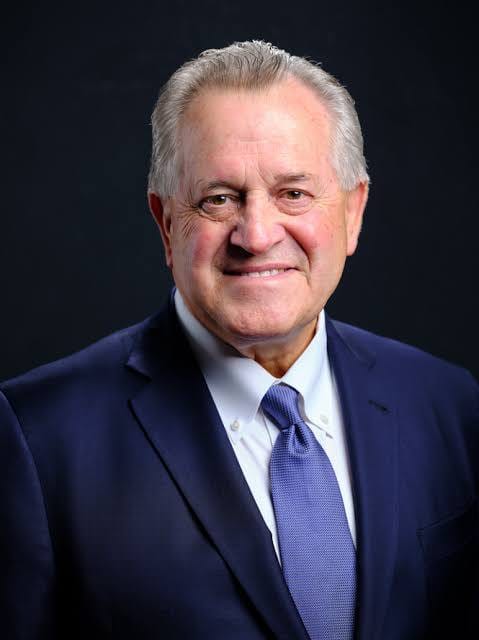T.J. Rodgers, SunPower and the Future of Solar Power in Utah — Part 1: How We Got Here

Publisher’s Note
This is Part 1 of a two-part Utah Money Watch investigation into the evolving relationship between SunPower, Utah’s solar economy, and T.J. Rodgers. Part 2 is slated to be published tomorrow.
The Headline That Started It All
19 November 2025 — Lehi, Utah — In my experience I find that every so often a headline grabs me by the collar and demands I stop what I'm doing.
This story began with one such headline, and the deeper I followed it, the stranger, wider, and more consequential I found the story underlying the headline became.
That headline was this:
SunPower Signs LOI to Acquire Ambia Solar
Based on the headline alone I thought, "Oh, not that big of a deal."
Here's a company I'm aware of — SunPower (NASDAQ: SPWR, SPWRW) — with operations in Utah, that's signed a Letter-of-Intent to acquire another firm, a firm I don't know (Ambia Solar).
Not a big deal, or so I thought, because then I started reading.
- SunPower expects to "... (add) $83.6 million in annnual revenue starting in Q1’26." (Well ... that's certainly not nothing.)
- The dateline for the release reads Orem, Utah and NOT Fremont, California.
So I kept reading, and the more I read, the deeper I looked, and the stranger (and more consequential) I felt the story became.
Because the actual truth is simple: Utah didn’t suddenly become a solar state last week.
It's been one for more than a decade.
In fact, as I've observed from afar the sometimes circuitous / convoluted doings of Silicon Valley's famous, billionaire semiconductor industry maven, T.J. Rodgers, it's mostly been with a sense of curiosity, not awe.
But as I read deeper into the SunPower release, readings that led me to other announcements, investor presentations, and filings with the U.S. Securities and Exchange Commission, I found that my curiosity began to shift.
"Is it possible," I mused, "that what Rodgers is doing with SunPower may, in fact, mark the re-emergence of Utah’s Solar Moment, not its beginning."
So I kept digging, researching, and uncovering, all in an effort to
- Follow the money,
- Build a timeline, and hopefully,
- Figure out what Rodgers was actually doing with SunPower.
And Utah.
So welcome to Part 1 of "T.J. Rodgers, SunPower and the Future of Solar Power in Utah."
Utah’s First Solar Moment (2011–2020)
If you’re new to Utah's solar power story, start here.
Utah has been in the energy business since shortly after the pioneers arrived in the Salt Lake Valley in 1847, first with coal, and then with oil and natural gas.
But the solar industry?
The invisible nascent beginnings of Utah's solar ecosystem actually started in Lehi, Utah in 1999 when Todd Pedersen and Keith Nellesen started APX Alarm Security Solutions.
It wasn't until some 12+ years later when the then re-branded Vivint launched Vivint Solar in October 2011 as its solar division.
Thirteen months later, alternative investment firm, Blackstone Group, acquired controlling interest in Vivint (and its divisions), for over $2.0 billion, a move which led to Vivint Solar becoming a standalone company.
Three years after its creation, Vivint Solar became a publicly traded company on the New York Stock Exchange in October 2014.
And between 2014 and 2019, the firm generated more than $1 billion in revenue.
In October 2020, Sunrun acquired Vivint Solar for $3.2 billion, a transaction that instantly anchored Utah as one of the most strategically important nodes in the U.S. residential solar industry.
While Vivint Solar was clearly the brightest star in Utah’s solar ecosystem (back then, at least), it was not its only player in what I consider to be Utah's first solar moment
In fact, according to 2nd quarter 2025 data provided by the Solar Industry Energy Association, Utah currently hosts roughly 120 solar companies (19 manufacturers, 50 installers/developers).
In other words, when you step back a picture begins to emerge.
Utah’s Solar Moment has already happened. Once.
You could even say it's still going. That's not the question.
The question isn’t whether it happened.
The real question is,
Is it happening again?
Meanwhile, "Back to the Future" in Silicon Valley
To understand SunPower’s gravitational drift toward Utah, you have to start with T.J. Rodgers.
Who is he?
According to Wikipedia, Rodgers was born in 1948 in, Oshkosh, Wisconsin. That makes him 77 today.
He received bachelor's degrees in Chemistry and Physics from Dartmouth College in 1970, graduating as Salutatorian.
He went on to earn a master's degree and a Ph.D. in Electrical Engineering, both from Stanford University, the latter bestowed in 1975.
Following a combined seven years working for two semiconductor industry companies in what had been coined already as Silicon Valley, Rodgers co-founded Cypress Semiconductor in 1982 with five colleagues from Advanced Micro Devices.

Rodgers was named as its Founding CEO, and Cypress went public in 1986.
Cypress specialized in microcontrollers and memory chips, the bedrock of modern electronics, and also pioneered what became known as PSoCs (Programmable System-on-Chips).
Rodgers’ role at Cypress built his reputation as a tech executive, consolidator and deal-maker, with Rodgers leading the way to 26 acquisitions by Cyprus prior to his stepping-down as CEO in 2016.
The year before, however, Cyprus had over 6,000 employees and produced $1.6 billion in revenue (in 2025 dollars).

While he attended Stanford, Rodgers met Richard Swanson, a Ph.D. classmate who went on to form SunPower in 1985 after receiving grants from the Electric Power Research Institute and the U.S. Department of Energy.
That was SunPower v1.0.
However, when SunPower teetered on the edge of bankruptcy in 2001, it was Rodgers who personally loaned SunPower $750,000.
The following year, the Rodgers-led Cypress Semiconductor took a minority stake in SunPower, and then acquired majority control by 2004.
That preceded SunPower's IPO in 2005; Rodgers was its Chairman.
That was over 20 years ago, and yes, that was SunPower v1.0.
The version the world knew.

The version that ultimately crumbled.
Not because the technology failed, per se, but rather because the economics did:
- High-efficiency panels with high manufacturing costs,
- Global competition,
- Policy swings,
- Restructurings,
- Spin-offs, and
- Divestitures.
By 2023, SunPower v1.0 was a shell of itself.
And in 2024 it filed for bankruptcy.
End of story, right?
Nope. Wrong.
Why?
Because T.J. Rodgers had been both indirectly and directly involved in the solar industry for close to a quarter-of-a-century by them.
The Re-Entry: Complete Solar + Solaria Becomes Complete Solaria (2023–2024)
Here’s the twist.
In July 2023 a Special Purpose Acquisition Corporation named Freedom Acquisition I Corp. announced a business combination with what became Complete Solaria — the merger of Complete Solar and Solaria.
AUTHOR'S NOTE: As a so-called "blank check" firm, such SPACs are formed as publicly traded companies with the specific purpose of finding going concern to
Merge with,
Transform the private company into a publicly traded firm, and
Insert cash into now publicly traded firm.
And Rodgers personally committed $10 million to the transaction.

Was Rodgers a behind-the-scenes founder of the SPAC? No.
As noted in its SEC filings, Freedom Acquisition I Corp. was formed in 2021 and led by Tidjane Thiam, Adam Gishen and Edward Zeng.
Rodgers did not hold management or governance roles in the SPAC, and his involvement was strictly as a financial backer and anchor investor, albeit a meaningful one.
Which brings us to Utah.
The CFO Move That Foreshadowed Strategy (Lehi, June 2024)
In June 2024, nearly one year after its SPAC merger, Complete Solaria named Daniel Foley as its Chief Financial Officer, a graduate of the University of Utah, where he received his bachelor's degree in Economics.
But as noted in the news release announcing his hiring, Foley would not be based based California, but in Lehi, Utah.
Specifically, the release includes this sentence:
“We needed an experienced, business-savvy, high-tech CFO to seed our headquarters finance group in Lehi, Utah … the center of Utah’s ‘Solar Valley.’”
It should be noted that this was months before SunPower’s asset acquisition.
Months before the Ambia Solar announcement (which I haven't mentioned yet)
Months before the deal with Sunder Energy.
In other words, Rodgers had already placed a corporate stake in the ground here in the State of Deseret.
The Utah Ties Deepen (Logan, July 2024)
On 15 July 2024, Complete Solar (aka, Complete Solaria) acquired Core Energy, a Logan-based solar EPC firm (Engineering-to-Procurement-to-Construction), with 37 Utah employees joining the company.
Cole Farmer, CEO and Founder of Core Energy, became head of Sales/Marketing for the Complete Solar.
Given that the cost of the acquisition was not disclosed, it was clearly not a legally "material" transaction.
But was strategically important?
No question, as it added another building-block to what Rodgers was quietly assembling in the state.
In other words, piece by piece, the map was shifting.
SunPower v2.0 Is Born (2024–2025)
The next month, August 2024, Complete Solaria won its $45.0 million "stalking-horse bid" for the bankrupt SunPower, as noted in this writeup by Seeking Alpha.
{AUTHOR'S NOTE: A stalking-horse bidder, for the uninitiated, sets the minimal baseline price in bankruptcy proceedings so other bidders must exceed it to be able to acquire a company out of bankruptcy.}
That said, Complete Solaria won the bid and acquired key assets of SunPower.
In April 2025 the company re-branded as SunPower.
- Same ticker,
- New company,
- New operations,
- New strategy,
- New geography, and significantly,
- New momentum.
The Utah Center of Gravity Becomes Unavoidable
Interestingly, for the past year (since mid-November 2024), every SunPower news release has carried an Orem, Utah dateline.
By contrast, the company's filings with the SEC still list Fremont, California as SunPower's headquarters, a detail that matters from a legal standpoint, but likely not for operations.
And to-be-honest, it's likely an oversight, for on a day-by-day basis, the company has already "moved" here from California.
And then came the moment that, in hindsight, made it impossible to ignore — at least for me.
Sunder Energy Changes the Game (September 2025)
Fast-forward to 22 September 2025 when SunPower announced it was acquiring South Jordan, Utah-based Sunder Energy.
This was not a small transaction, as SunPower would pay "... $40 million in cash plus 10 million shares of common stock (to acquire Sunder), subject to SunPower stockholder approval."
Arguably, it was seismic, at least for SunPower and Utah's solar power industry.
At the time, Sunder ranked No. 11 nationally by installed megawatts.

Sunder also projected $74 million in sales revenue for 2025.
Additionally, 93% of Sunder's revenue was derived via the TPO business model (Third-Party Ownership).
{AUTHOR'S NOTE: The residential solar industry once revolved around a dominant incentive — the federal ITC (Investment Tax Credit).
Under the ITC model, homeowners purchased solar systems outright (often over time), claimed a large tax credit, and installers captured margin.
But as the tax credits associated with ITC began "stepping down," the industry shifted.
Now the growth engine in the residential solar industry is TPO (aka, Third-Party Ownership); this is where customers lease systems or sign power-purchase agreements with a solar company rather than buying equipment outright.
Conversely, TPO reduces upfront cost savings for homeowners, stabilizes revenue for installers, and is less exposed to volatile tax-credit cycles.
In other words, Sunder’s 93% TPO model positioned SunPower perfectly for its next chapter.
The deal also did something else:
- It doubled SunPower’s contracted, 1099-salesforce from 841 to 1,734 people;
- It expanded the firm's footprint from 22 states to 45 states, and
- It also brought senior executive sales leadership to SunPower.
As in Rodgers’ said in the news release,
"We have been working on Sunder as our top acquisition priority for exactly six months and seven days, ever since I met with their President, Eric Nielsen, in Mexico on my birthday to get to know him and Sunder better."
Four days later the acquisition closed, a transaction that SunPower claims creates the No. 5 company in the "... U.S. residential solar industry ... (based upon) installed megawatts, using data from Ohm Analytics."
In describing Sunder acquisition, Rodgers explained that because Sunder's nearly 850-person "dealer" workforce (his term, not mine) are not employees but rather independent contractors managed by a mere 20-person employee base at Sunder, "... this new low-overhead revenue will generate an operating income profit record for us in Q4’25.”
I also found it quite instructive to review and contemplate Rodgers' closing comments in the release announcing the close of the Sunder acquisition, namely
"I’ve been asked why it took six months to create the Sunder deal but less than a week to close it. That’s because this deal is about retaining an independent 1099 salesforce and learning from the experience. To that end, we have carefully vetted every aspect of retaining a world-class sales team, from their salary and stock compensation through the HR and IT systems that connect them to us. We even did a one-quarter experiment to run 64 Sunder deals through the SunPower systems and study the reactions of their salesforce. Based on that trial run, the acquisition at the sales level is most simply described as doubling the SunPower salesforce from 841 to 1,734 representatives, while adopting the Sunder sales software and methods on both sides.
"When I was the CEO of Cypress Semiconductor from 1982 to 2016, we acquired 26 chip companies, each of which became a new division at Cypress that joined us because of our wafer fabrication plants and worldwide sales force. During those 26 cycles of learning, we developed a suite of formal specifications on how to perform every aspect of an acquisition. We are now using that playbook to formally integrate Sunder into SunPower using an 10-person leadership team that oversees progress on 10 specified integration tracks run by 18 senior managers, in pairs from each company on each track. In just one week, we have created a database with 60 carefully written integration deliverables from our integration specification. When that list reaches approximately 310 deliverables one month from now, the scope of the acquisition operation will have been fully defined. And when the last of the 310 deliverables is completed about one quarter from now, we will have integrated the two companies with the intent of capturing the full value of Sunder for our shareholders, which will also include every Sunder permanent employee by then. With an elapsed time of 180 days from losses to positive operating income, the SunPower asset acquisition was clearly successful – and this one will be too, but on a faster timetable, now that we know how to dance."
No doubt, it's a horrifically long quote for a news release.
But think about some of the nuggets from that quote:
- "... this deal is about retaining an independent 1099 salesforce and learning from the experience" (Emphasis added.)
- "We even did a one-quarter experiment to run 64 Sunder deals through the SunPower systems ..." (Emphasis added.)
- Under his CEO leadership at Cypress Semiconductor, "... we developed a suite of formal specifications on how to perform every aspect of an acquisition." (Emphasis added.)
- "We are now using that playbook to formally integrate Sunder into SunPower using (a) 10-person leadership team that oversees progress on 10 specified integration tracks run by 18 senior managers, in pairs from each company on each track." (Emphasis added.)
- "In just one week, we have created a database with 60 carefully written integration deliverables from our integration specification." (Emphasis added.)
- "... now that we know how to dance." (Emphasis added.)
In plain English, Rodgers is essentially saying,
"I have a playbook that allowed me to successfully close 26 acquisitions while CEO of Cyprus. That playbook worked for the bankruptcy acquisition of SunPower. It's already in play with the Sunder acquisition. And it will work again in the future."
In other words, it's all part of a planned sprint, by Rodgers and by SunPower.
Then the November Surprise: Ambia Solar (2025)
Which brings us back to the headline that sparked this journalistic investigation:
SunPower Signs LOI to Acquire Ambia Solar.
The day was Tuesday, 11 November 2025, and in that release, SunPower shared the following about Ambia:
- That its projected 2025 revenue was $83.6 million.
- Its operational metrics: best-in-class.
- Its leadership: deeply rooted in Utah’s solar culture.
- Its backlog: 72 % TPO (Third-Party Ownership).
In other words, another acquisition in the works, another Utah company, and another dateline that wasn’t California.
Naturally, this deal is not done yet.
And so far, there is no official word from SunPower or Ambia suggesting when it might occur.
If I were to guess, my supposition is that it would take place before year-end as I suspect CEO Rodgers would want that figurative feather in the SunPower cap before the start of 2026.
So Where Does This Leave Utah?
At this point I think that the bigger story is not that SunPower is coming to Utah.
It’s been here for some time.
I believe the deeper question — the one I suspect Utah Money Watch readers care about — is whether Utah is entering a new period of solar leadership.
Let's call it Utah’s Solar Moment v2.0.
Whether T.J. Rodgers’ consolidation engine puts Utah at the center of the U.S. residential solar landscape is something yet to be seen.
But he's already navigated three acquisitions in his foray into Utah, with a fourth potential acquisition pending at the LOI stage.
So, whether this becomes Utah’s Solar Moment, again — v2.0 (if you will) — is yet to be seen.
But then, as I was wrapping-up Part 1 of this two-part writeup, I stumbled across something I had not seen previously buried on the SunPower website:
A SunPower advertisement that apparently ran in the Wall Street Journal earlier in 2025. (See below.)

Two things that strike me from T.J. Rodgers' "letter" in this ad:
- Affirmation that, as of the undisclosed actual date of this ad, Orem, Utah was/is the headquarters of SunPower.
- That Rodgers is committed to getting SunPower to over $1 billion in revenue. (No date tied to that goal, but a target nonetheless.)
{NOTE: to get a greater sense of Rodgers, his take on renewable energy/solar power, and his vision for SunPower, I invite you to check out his interview on the FACTOR THIS Podcast. The recording is below.}
SunPower's T.J. Rodgers and his recent interview on the FACTOR THIS Podcast.
So ... What's Next?
That's where Part 2 of this two-part journalistic exploration comes into play.
Because I believe that what’s happening here in Utah and its solar power and energy ecosystem isn’t small.
And it's not accidental.
And it is definitely not finished, at least if T.J. Rodgers has anything to say about it.
Part 2 will be published tomorrow.
Publisher's Note
This article/report was originally published and distributed to our Subscribers at approximately 7:45am MT on Wednesday, 18 November 2025.
However, if this report/article came to your attention sometime after this date/time and you'd like to change that, then (to become a subscriber), please
1. Click on a "Subscribe" button on any Utah Money Watch webpage (visit www.UtahMoneyWatch.com),
2. Enter in your name in the proper field in the popup window that appears on-screen, and
3. Enter your preferred email address in the proper field too.
That's it. Thanks.
Team Utah Money Watch
P.S. And watch for Part 2 of this series tomorrow.




Comments ()